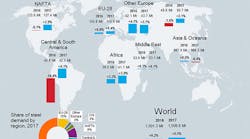Global production of raw steel totaled 136.5 million metric tons during January 2017, a 1.75% rise from the previous month’s total and a 7.0% increase over the January 2016 total. The figures are based on some noteworthy estimates, according to the World Steel Association, including estimated output of 67.2 million metric tons from China, which represents an increase of 2.7% over the January 2016 result.
The World Steel Assn. tracks monthly raw-steel output and capacity utilization rates for 67 countries — now, including Vietnamese production for the first time. Raw (or crude) steel is the output of basic oxygen furnaces and electric arc furnaces that is cast into semi-finished products, such as slabs, blooms, or billets. World Steel reports tonnage and capacity utilization data for carbon and carbon alloy steel in 66 countries; data for production of stainless and specialty alloy steels are not included.
Last fall World Steel issued a short-range outlook for steel demand, and forecast that 2017 global steel demand will grow by 0.5% and reach 1.51 billion metric tons. The January results suggest a more stable situation for the global steel industry, which has strained under weak demand and excess capacity for nearly three years.
The Chinese situation is particularly critical, as industrial demand has remained mainly flat, export opportunities have been reduced, and the nation’s central planners continue to implement an aggressive program of capacity reduction and forced consolidation of producers’ holdings.
The estimate of 67.2 million metric tons for China’s January output indicates an increase of 7.4% over the nation’s January 2016 output, which would be a high result indicated by a January 2016 drop in Chinese steel production.
Elsewhere in Asia, Japan’s steelmakers produced 9 million metric tons of raw steel in January 2017, an increase of 2.7% compared to January 2016.
World Steel estimated India’s January raw steel output at 8,400 metric tons, 11.98% higher than the year-ago total.
South Korea’s steelmakers produced 5.86 million metric tons during January, 3.2% more than the January 2016 result.
In the European Union, total raw-steel output for the 28 nations was 13.8 million metric tons, 7.47% higher than during December and 2. 43% higher than during January 2016.
Germany, the largest steel-producing nation in Europe, produced 3.65 million metric tons during January, 13.02% over the December output and 1.24% more than January 2016’s tonnage.
Italian steelmakers produced 1.825 million metric tons of raw steel during January, 2.76% over the preceding month but just 0.3% higher year-over-year.
Spain’s raw steel output for January was 1.163 million metric tons, or 25.6% higher than December. However, that figure is 4.2% lower than last January’s total.
French steelmakers also reported a marked year-over-year decline: January 2017 raw steel output there was 1.145 million metric tons, 0.2% higher than for December but 14.05% lower than for January 2016.
Beyond the EU, Russian steel output for January was 6.183 million metric tons, down 0.63% from December but 11.6% higher than the January 2016 result.
In Ukraine, steel production rose to 2.1 million metric tons, 4.52% higher than December and 8.5% higher than January 2016.
The Turkish steel industry produced 2.93 million metric tons during January, 3.75% more than during December and 12.78% more than during January 2016.
Brazilian steelmakers produced 2.856 million metric tons during January, 20.61% more than the December tonnage and 14.04% more than the January 2016 result.
U.S. steelmakers’ January 2017 output rose to 6.874 million metric tons (7.58 million short tons), which is 6.46% more than the December result and 6.47% more than the January 2016’s output.
Last, World Steel Assn. reported that January’s raw-steel capacity utilization rate for the 67 countries was 68.5%, 0.9% more than December’s rate and 3.4% higher than for January 2016.











